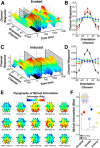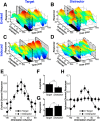Induced α rhythms track the content and quality of visual working memory representations with high temporal precision
- PMID: 24872563
- PMCID: PMC4035520
- DOI: 10.1523/JNEUROSCI.0293-14.2014
Induced α rhythms track the content and quality of visual working memory representations with high temporal precision
Retraction in
-
Author-initiated retraction: Anderson et al, Induced alpha rhythms track the content and quality of visual working memory representations with high temporal precision.J Neurosci. 2015 Feb 11;35(6):2838. doi: 10.1523/JNEUROSCI.0074-15.2015. J Neurosci. 2015. PMID: 25673870 Free PMC article. No abstract available.
Abstract
Past work has suggested that neuronal oscillations coordinate the cellular assemblies that represent items in working memory (WM). In line with this hypothesis, we show that the spatial distribution of power in the alpha frequency band (8-12 Hz) can be used to decode the content and quality of the representations stored in visual WM. We acquired EEG data during an orientation WM task, and used a forward encoding model of orientation selectivity to reconstruct orientation-specific response profiles (termed channel tuning functions, or CTFs) that tracked the orientation of the memorandum during both encoding and delay periods of the trial. Critically, these EEG-based CTFs were robust predictors of both between- and within-subject differences in mnemonic precision, showing that EEG-based CTFs provide a sensitive measure of the quality of sensory population codes. Experiments 2 and 3 established that these EEG-based CTFs are contingent on the voluntary storage goals of the observer. When observers were given a postsample cue to store or drop the memorandum, the resulting CTF was sustained in the "store" condition and rapidly eliminated following the "drop" cue. When observers were instructed to store one of two simultaneously presented stimuli, only the stored item was represented in a sustained fashion throughout the delay period. These findings suggest that the oscillatory activity in the alpha frequency band plays a central role in the active storage of information in visual WM, and demonstrate a powerful approach for tracking the precision of on-line memories with high temporal resolution.
Keywords: EEG; attention; decoding; oscillatory activity; tuning function; working memory.
Copyright © 2014 the authors 0270-6474/14/347587-13$15.00/0.
Figures







References
Publication types
MeSH terms
Grants and funding
LinkOut - more resources
Full Text Sources
Other Literature Sources
Miscellaneous
